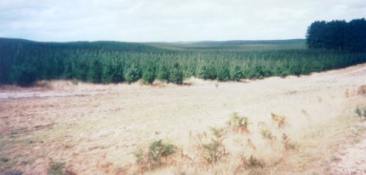Region: PortlandLegal Number: LEGL/93-10Plantation: Kentbruck
Conservation Priority: MediumPlantation maps of region herePlantation located in Glenelg Water Supply Protection AreaPortion of Plantation is located in Groundwater (Border Agreement) South Australian-Victorian Border Groundwaters Agreement - Zone 1BPlantation within S.E.A.S Sapfor (Auspine) area of
supply.
Aerial View of Kentbruck Plantations looking east adjoining Lower Glenelg National Park. Photo dates from approximately 2005. This plantation was very likely to be aerially sprayed with 2,4,5-T between 1968 and 1977. The Dioxin TCDD may still exist in soil in this plantation. For more historical data on 2,4,5-T click here. For more information concerning the continuing health crisis concerning 2,4,5-T please forward to here. Herbicides Used by Hancock in Pine Plantations South Western Victoria
THREATENED FISH NOTES - GLENELG RIVER: Yarra Pygmy
Perch and Ewens
Pygmy Perch found in the Glenelg
system. Both species listed under the Flora and Fauna Guarantee Act
in Victoria and threatened. Site visit Feb 01: Drove through middle of plantation (93-11) - same as 21/1/01. Took a left turn at the road that separates 93-11 from 93-10. Took some photos. Turned onto the Nelson Winnap Road that borders Lower Glenelg National Park. Took photos. Drove onto Portland Nelson Road. Quite a significant vegetation strip along highway from Wade Junction to start of 93-11. The coastal strip still apparent although greatly diminished in 93-11. "Groundwater: "In south-western Victoria the Otway Basin stretches from the South Australian border almost to the west of Geelong. It contains older sediments of Upper Cretaceous and Lower Tertiary age, up to 2000 m in thickness. These include four sand aquifers and two limestone aquifers. The sand aquifers of the Wangerrip Group are confined over most of the Basin and their recharge zones are located on the margins of the Otway Range in the east and the Merino Tablelands in the West. The groundwater moves towards the coast, increasing in salinity along its floorpath . . ." p268 State of the Environment Report 1988 Victoria's Inland Waters. Office of the Commissioner for the Environment. "Shallow aquifers in the Glenelg River Basin occur in four main geologic units . . . The third unit is a Newer Volcanic aquifer which lies along much of the Basin's southern boundary, particularly in the east. This fractured rock aquifer is composed of basalt, scoria and tuff. The fourth unit is composed of dune sand and beach deposits extending from the south-west corner of the Basin up to the western boundary and along the northern boundary. It is known as the Bridgewater formation. A deep aquifer system exists in the south-west of the Basin and extends to the top of the western boundary and half-way across the southern boundary. This sand aquifer, which is significant as a water source, occurs within the Wangerrip Group. Generally, groundwater quality in the Basin decreases towards the north where it is saline. A large reserve of fresh water is held in the north-east corner of the catchment and in the south-west the water is of marginal quality . . ." p295 Water Victoria A Resource Handbook - Department of Water Resources Victoria 1989. |

